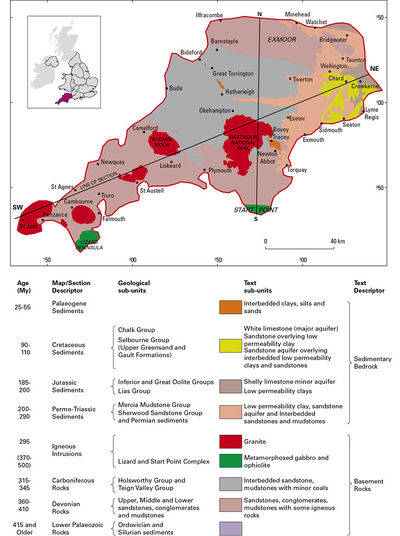Category:17. South-west England area

This account provides a broad perspective of the geology of South-west England, encompassing the counties of Cornwall, Devon and part of Somerset. It is bounded by the Atlantic, Bristol Channel and the English Channel and a line from Bridgwater through Crewkerne to Lyme Regis. The region is predominantly rural with the major cities and towns including Penzance, Truro, Newquay, Plymouth, Torquay, Exeter, Taunton and Barnstaple. Figure P902268 provides a geological sketch map of this region showing the rock types occurring in relation to the major towns and cities. This account outlines the geology to a depth of at least a kilometre and summarises the current and historical use of the geological resources in the area.
The near-surface geology of the region is well known due to the many quarries, mines, coastal cliffs and shallow boreholes. The region has been quarried for slate, granite and limestone for building stone. The extractive industry has also worked sands and gravels and the region has produced large quantities of china clay (kaolin). Historically, Cornwall and Dartmoor include some of the most important metalliferous mining districts in the British Isles, and these have been particularly important sources of copper, tin and arsenic from prehistoric times up to the twentieth century. More locally tungsten has been mined on Dartmoor in the past and new mining is in prospect, while there has been historic production of silver and lead on Exmoor.
At greater depths, below about 200 m, our understanding relies heavily on information from former mines and a few deeper boreholes. The majority of the boreholes are clustered in the south-west of the region and were drilled for mineral exploration aimed at the minerals associated with the granites. These are the solidified remains of bodies of molten rock or magma, similar to those that lie beneath many active volcanoes today at depths of a few kilometres. The very deepest of these boreholes go down over a kilometre. Other deep boreholes were drilled to explore for hydrothermal energy, oil and gas. Patterns of the Earth’s gravity and magnetic field, the latter measured with great sensitivity from aircraft, also give us clues as to the deeper geological structure of parts of the region and in particular the subsurface extent of the granite. With the exception of the easternmost parts, in most of the region the rocks do not contain sufficient water to provide a source for drinking water supply and therefore almost all the water for the region comes from surface rivers and reservoirs; however, small domestic supplies are abstracted in some areas. The region does not contain valuable oil, gas or coal deposits at depth; consequently there is limited information from exploration for these commodities. However, some geophysical surveys which provide information on the rocks by sending sound waves through the ground (seismic surveys) have provided data for the south-eastern part of the region around Lyme Regis, where it is useful to help interpret the deeper geological structure.
Subcategories
This category has only the following subcategory.
The number of included categories (C), pages (P) and files (F) is stated in brackets.